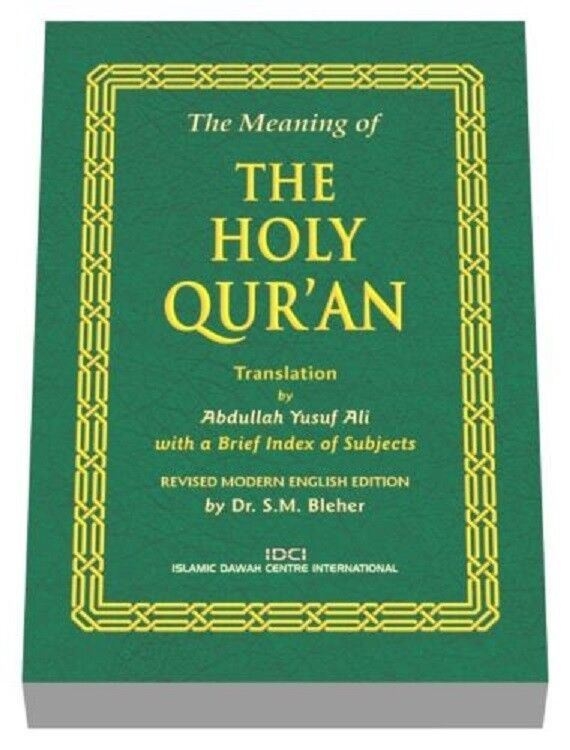
ALL BOOKS ARE NEW PRINTS.
Tajweed
Rules of the Quran New Edition
Every single Muslim has to recite Qur'an in Salah but many of us do not
realize that reciting the Qur'an correctly, observing the rules of
recitation (tajweed) is not an advanced science for expert reciters
alone, rather it is an obligation upon each and every one of us whenever
we recite the Qur'an.
This set of 3 renowned books on learning the Tajweed rules of the Quran
will help one to understand the tajweed rules and correct their
recitation with the help of a teacher. Insha-Allah. It is also great
Islamic schools & Quran teachers to teach their students
This is a guide for studying tajweed. The student who uses this book is
expected to have a basic grasp of Arabic before starting this course.
The student should know all the Arabic letters and vowels and be able to
read at an elementary level. This book is either for an English
speaking student studying the Qur'an in an Arabic environment, but
needing explanation of the Arabic terms in English, or a student
studying the explanations of tajweed in English, but learning the basic
concepts in Arabic so they may integrate into the Arabic terms and
definitions throughout the book, since the science of tajwid is an
Arabic science.
Book
1:
This is a guide for studying tajweed. The student who uses this book is
expected to have a basic grasp of Arabic before starting this course.
The student should know all the Arabic letters and vowels and be able to
read at an elementary level. This book is either for an English
speaking student studying the Qura'an in an Arabic environment, but
needing explanation of the Arabic terms in English, or a student
studying the explanations of tajweed in English, but learning the basic
concepts in Arabic so they may integrate into the Arabic terms and
definitions throughout the book, since the science of tajweed is an
Arabic science.
This book explains the articulation points of the Arabic letters, the
rules of noon saakinah, meem saakinah, and lam saakinah. It explains all
of the different lengthenings (mudood), and how voweled, and
non-voweled letters are formed. The qalaqah mechanism is explained in
the last chapter. Terms are introduced in Arabic, and the translated
into English. Explanations are done in English, but with integration of
Arabic terms, as they are learned.
A student of the Qur'an cannot except to learn tajweed simply by
studying this book. The learning of proper Qur'anic recitation can only
be done by listening to a qualified Qur'an teacher recite, then reciting
to them and receiving corrections from the teacher.
Book 2:
By Allah's grace, this is the second part of what shall be, insha'
Allah, a three part series on the rules of tajweed of the Qur'an, for
the recitation of Hafs from 'Aasim by the way of Ash-Shaaibiyyah. The
book is intended to be a guide for non-Arabs with a good grasp in
English in studying tajweed.
This book explains the concept of the accent(an-nabr) in the recitation
of the Glorious Qur'an and the conditions of its use, it also defines
and explains the important chapter on the characteristics of the
letters, velarization and attenuation (tafkheem and tarqeeq) are covered
in the part, as well as the concept of the two alike, the two similar,
the two close, and the two far and the rules for idghaam terms is made
in this book to assist the student in understanding the last chapter,
that of the connecting hamzah(hamzah al-wasl).
The explanations of the different subjects are in English and the Arabic
terms are translated. This is to assist the student in understanding
and encourage them to learn the Arabic definitions and terms. This book
should facilitate non-Arabs studying tajweed whether they are in a
classroom with explanations taught in Arabic or in English.
This book cannot replace the importance of reciting to and being
corrected by a trained teacher of tajweed, instead it is a guide and an
aid in understanding the concepts of tajweed, the application can only
be refined by recitation and correction.
Book
3: This last part of the Tajweed Rules of the Qur'an covers more
advanced but very important subjects. The stop, start, and
discontinuation of recitation are covered, as well as stopping on words
ending with consonants (saheeh ending) as well as words ending with the
alif, ya' or wow (weak endings) and what is and what isn't allowed when
stopping on these types of words. The special rules and words for Hafs
are explained in this book as well as the lesser known but valuable
subject of the writing of the Glorious Qur'an, its history, the rules
for writing the Uthmani Qur'an are explained as well as the female ha'
written as a ta', and the words written disconnected and/or words joined
in writing.
Author: Kareem czerepinski
Publisher: Al Khair Publications
Binding: Paperback
Weight: 1200g (approx)
Size: 29.5x21cm (approx)
Reviews
Coming soon...
Additional Informations
Coming soon...
Also Purchased
Below are a few additional products purchased with this product.






